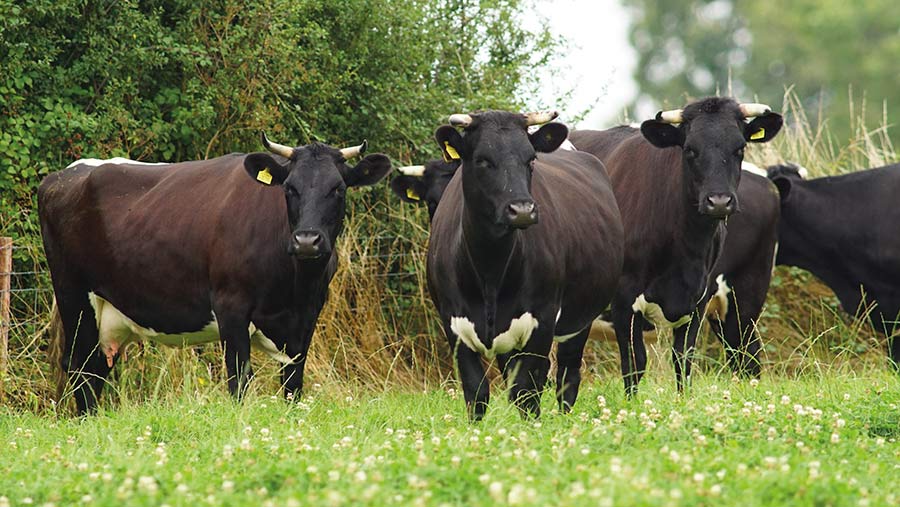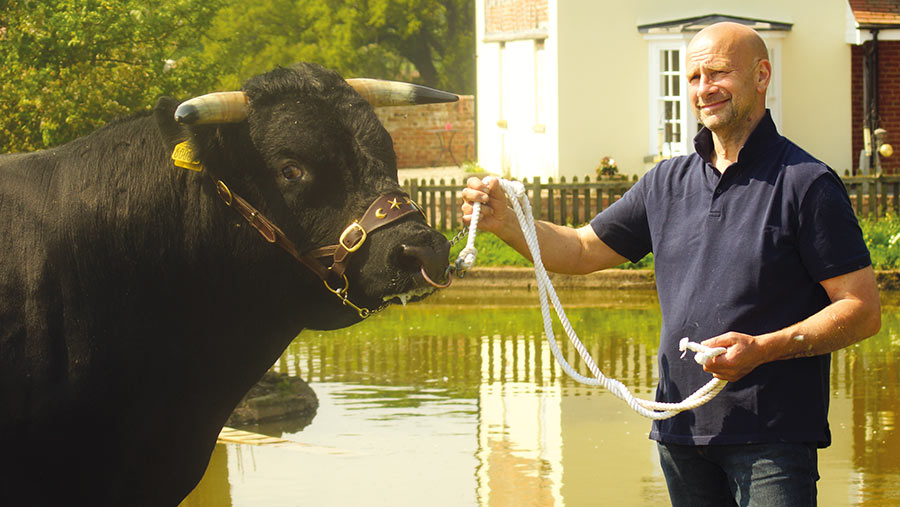Gloucester cattle can be profitable, says breed trust
 © Clifford Freeman
© Clifford Freeman Gloucester cattle may be one of the rarest breeds in the UK, but commercial opportunities exist both in the dairy and meat sectors, delegates to a recent open day organised by the Gloucester Cattle Society and the Rare Breeds Survival Trust (RBST) were told.
The dual-purpose breed used to be quite prolific, in the Severn Vale in particular. But by 1972, as more farmers turned to faster growing and heavier Continental breeds, only one herd of Gloucesters remained.
See also: Gloucester cattle at risk of dying out, warns charity
Efforts by the Gloucester Cattle Society, alongside the RBST, helped numbers improve, reaching 54 herds by 2006.
But since then, there has been a further slump – to just 27 herds – and the breed is now categorised as a “priority” breed on the RBST watchlist.
Despite this, breed enthusiasts insist there is a commercial future for Gloucester cattle, as consumer interest grows in high-quality, environmentally responsible meat and dairy products.
Gloucester Cattle Society member Steve Gennings, who farms in West Sussex, spoke of the breed’s “excellent commercial attributes”.
“As well as being a truly dual-purpose animal, producing both high-quality beef and milk from poorer quality grazing, they also calve easily, are docile and are naturally good mothers,” he said.
Dairy opportunities
There are also opportunities on the dairy side.
Owner of one of the oldest Gloucester herds in the world, Charles Martell has been making Double Gloucester, Single Gloucester and Stinking Bishop cheeses for 50 years.
Single Gloucester cheese has Protected Designated Origin status and can only be made in Gloucestershire using the milk from a dairy herd containing Gloucester cattle.
Mr Martell said Gloucester cattle were excellent for dairy production, given their flat lactation curve and even production of milk for up to 300 days.
The open day was part of a bigger project between RBST and the Gloucester Cattle Society with the aim of securing the breed’s future.
“What we are trying to do is promote the breed and its products generally, and also to do some genetic work – reviewing what’s in the gene bank, then looking to collect from appropriate bulls to make them available for breeders,” said RBST chief executive Christopher Price.
“Of all the breeds we deal with, the Gloucester is one where artificial insemination is used a lot, so it is particularly important to try and manage the genetic diversity.”
Keys to commercial success with Gloucesters

© Clifford Freeman
Finding the right market and rearing the cattle to deliver consistency and quality are the keys to commercial success for Gloucester cattle breeder and RBST trustee Clifford Freeman, who hosted the open day.
Mr Freeman runs the Noent herd at Everes’s Farm at Redmarley, Gloucestershire. With 285 head of cattle grazing around 285ha of owned and rented ground, his is the largest herd of Gloucester cattle in the country.
“We tend to service our bulling heifers at 24 months and use a Hereford bull for that first calf,” he explains.
“They are fairly late-maturing animals, so it is hard to tell which will be the best-quality animals to breed from.
“We keep the cross calves to sell as stores, and then sort the females out to retain the best for breeding – it gives us a cash crop, and we don’t want to keep too many poor heifers, as we are continually trying to improve.”
The very best first calvers are put to a Gloucester bull for their second and subsequent pregnancies. Their calves are then reared as sucklers on a 100% grass diet.
“Gloucester cattle are incredibly low maintenance,” says Mr Freeman. “As well as being grass-fed only, they calve by themselves almost always.”
The steers are generally finished at between 30 and 36 months. “We don’t push them as we have found over the past 10 years it is best to give them time to build the frame first, and then hang the meat on it.”
The finished animals are sent away for slaughter, just 30 minutes away, before the carcasses are returned to be hung and processed in the on-farm butchery.
The focus on quality, as well as continuity and consistency, has opened up a valuable market in the restaurant trade, with a good premium on all the hindquarter meat sold for steaks.
“Overall, I reckon we earn double the revenue from butchering and marketing our own meat compared to if we put them through the live auction ring,” says Mr Freeman.
On top of that, the business benefits from very low rents or even free grazing.
“We do a lot of conservation grazing, particularly on other people’s land who are signed up to Countryside Stewardship. They get the payment, we get the grazing at very low cost.”
